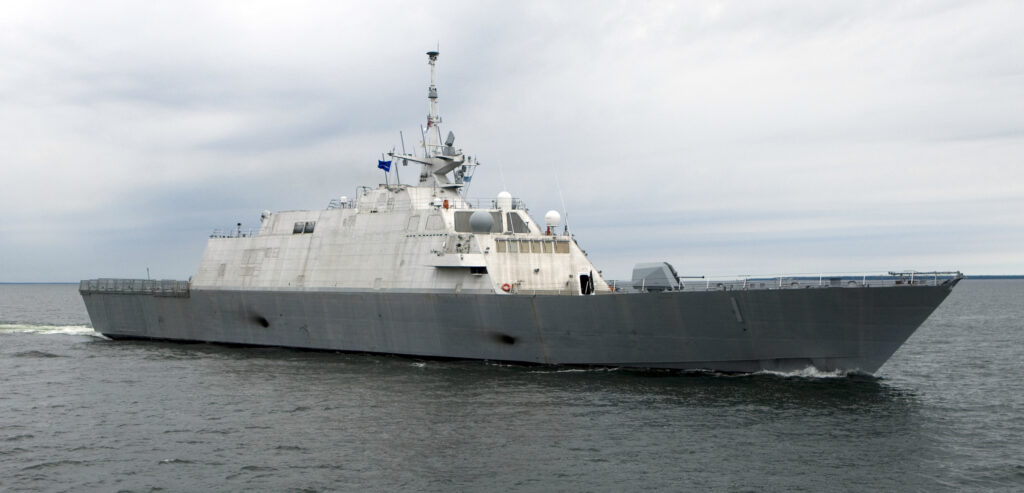
ARLINGTON, Va. — Normally the number of new U.S. Navy ships requested for the next a new fiscal year garners the most attention of reporters, but this time it was the number of ships the Navy is seeking to decommission that drew the most attention.
Under the Future Years Defense Plan, the size of the Navy’s battle force would shrink from 298 today to 280 in fiscal 2027. Chief of Naval Operations Adm. Michael Gilday has advocated divesting in order to invest, and this budget supports that concept.
During the Navy Department’s March 28 fiscal 2023 budget briefing at the Pentagon, Rear Adm. John Gumbleton, deputy assistant secretary of the Navy for Budget, said the Navy is requesting the retirement of 24 ships, compared with the construction of nine battle force ships.
Gumbleton listed the types of the 24 ships targeted for retirement:
- 9 littoral combat ships
- 5 Ticonderoga-class guided-missile cruisers
- 2 Los Angeles-class nuclear-powered attack submarines
- 2 Henry J. Kaiser fleet replenishment oilers
- 4 Whidbey Island- or Harpers Ferry-class dock landing ships
- 2 Montford Point-class expeditionary transfer dock ships
He said the retirements would save the Navy $3.6 billion over the Future Years Defense Plan.
Most, if not all, of the littoral combat ship retirements would be of the troubled Freedom variant and would save the Navy $50 million annually. Also, under the 2023 plan the LCS antisubmarine warfare mission package would not be installed on the remaining LCSs, with the ASW mission taken up by the new Constellation-class frigate.
The two Montford Point-class expeditionary transfer dock ships are less than 10 years old and their proposed retirement reflects changes in Marine Corps amphibious operational concepts toward more distributed maritime operations.
The Navy recently has pointed our more problems with the older Ticonderoga-class guided-missile cruisers to the level of safety concerns being a major issue.
The nine battle force ships requested for 2023 by the Navy include:
- 2 Virginia-class SSNs
- 2 Flight III Arleigh Burke-class guided-missile destroyers
- 1 Constellation-class guided-missile frigate
- 1 America-class amphibious assault ship
- 1 Flight II San Antonio-class amphibious transport dock ship
- 1 John Lewis-class fleet replenishment oilers
- 1 Navajo-class towing, salvage and rescue ship
For 2022, the Navy requested eight ships, but Congress increased the number to 13 in the enactment of that budget.
The 2023 budget would continue to fund the Columbia-class ballistic-missile submarine, the Ford-class aircraft carriers, and advance procurement for two Virginia-class nuclear-powered attack submarines.
Gumbleton said 2023 would be the last year for procurement of the San Antonio-class transport dock ship.
Also, under the Future Years Defense Plan, production of the Constellation-class guided-missile frigate would alternate one and two ships year by year.
Procurement of the light amphibious warship and the submarine tender replacement would begin in fiscal 2025, followed by the next-generation logistics ship in 2026. Research and development funding is provided for the large unmanned surface vessel and the extra large unmanned underwater vessel.
The 2023 budget also would fund the purchase of two used sealift ships for the Maritime Administration’s Ready Reserve Force.
The fiscal 2023 also requests funding for two LCAC 100-class ship-to-shore connectors and the service-life extension of two LCAC 01-class connectors; but does not request more new LCU 1700-class utility landing craft. The plan also would fund advance procurement funds for the refueling and comprehensive overhaul of the USS Harry S. Truman (CVN 75), which the Navy not long ago wanted to decommission to fund other priorities.
Rep. Rob Wittman (R-Virginia), ranking member of the House Armed Services Committee’s Seapower and Projection Forces panel, has been critical of the Navy’s “divest to invest” strategy, which is shrinking the fleet. He issued a statement March 28, excerpted below:
“I am particularly disappointed that even as we aim to grow our naval and projection forces, this budget continues the divest to invest strategy that will shrink our fleet once again, underinvest in the fifth-generation fighters we need to compete with peer adversaries, reduces our Air Force tanker force structure and once again prioritizes future technologies over the capacity and capabilities servicemembers need now to ensure we have a credible American military. I will work with my colleagues in Congress this year to ensure that we deliver a defense budget that genuinely invests in the national security of our nation.”






